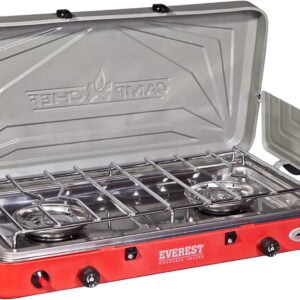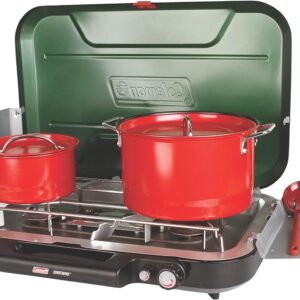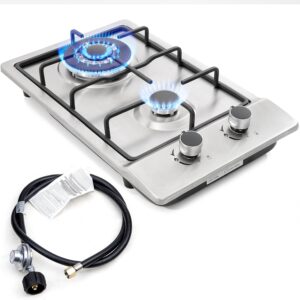Portable Gas Stoves
Showing all 7 results
-

Coleman Triton+ 2-Burner Propane Camping Stove, Portable Grill/Stove with Adjustable Burners, Instant Push-Button Ignition, Wind Guards, and a Total of 22,000 BTUs of Cooking Power
$109.99 -
Sale!

Gas One GS-3400P Portable Dual Fuel Stove – Propane and Butane Compatible – Camping Grill/Stove with Carrying Case, Adjustable Burners, and Wind Guards
Original price was: $32.99.$30.69Current price is: $30.69. -
Sale!

Camp Chef Everest 2 Burner Portable Stove
Original price was: $169.99.$159.99Current price is: $159.99. -
Sale!

Coleman Classic Portable 3-Burner Propane Camping Stove, Instant Ignition, Wind Guards, Pressure Control, Carry Handle – 28,000 BTUs
Original price was: $179.99.$158.00Current price is: $158.00. -

Koblenz Victoria 4-Burner Gas Stove, Bronze, 16,000 BTUs, 18″ x 24
$64.90 -

Forimo Portable Propane Gas Cooktop, Single Burner Stove with Auto Ignition, Tempered Glass, Ideal for Camping, RVs, Apartments, and Outdoor Cooking
$55.99 -

Forimo 12-Inch Stainless Steel Gas Cooktop with 2 Burners, Drop-in Propane/Natural Gas Cooker, Dual Fuel 12″ Gas Stove Top for Easy Cleaning (12″W x 20″L)
$99.99
A Comprehensive Guide to Portable Gas Stoves
Portable gas stoves are versatile cooking appliances that provide a convenient and efficient solution for outdoor cooking, camping trips, picnics, and emergency situations. These stoves use small gas canisters as fuel and are designed to be lightweight and easy to carry. In this guide, we’ll cover everything you need to know about portable gas stoves, including their types, features, usage, safety precautions, and maintenance.
1. Types of Portable Gas Stoves:
There are several types of portable gas stoves available in the market. The most common types include:
a. Single Burner Gas Stoves:
Single burner gas stoves come with one cooking surface and are ideal for individuals or small groups. They are compact, lightweight, and easy to transport.
b. Two Burner Gas Stoves:
Two burner gas stoves have two separate cooking surfaces, allowing you to cook multiple dishes simultaneously. They are perfect for larger groups and families.
c. Backpacking Stoves:
Backpacking stoves are compact and lightweight gas stoves designed for hikers and campers who prioritize portability and weight reduction.
2. Features to Consider When Choosing a Portable Gas Stove:
When selecting a portable gas stove, consider the following features:
a. Fuel Type:
Most portable gas stoves use propane or butane gas canisters as fuel. Choose the stove based on the availability and convenience of the fuel type.
b. Size and Weight:
Portability is a primary consideration for a portable gas stove. Opt for a lightweight and compact model that fits comfortably in your backpack or camping gear.
c. Number of Burners:
Decide whether you need a single burner or a two burner gas stove based on the number of people you’ll be cooking for and the complexity of your meals.
d. Heat Output:
Check the BTU (British Thermal Unit) rating to determine the stove’s heat output. Higher BTUs mean more heat, suitable for faster cooking.
e. Ignition Method:
Some stoves have built-in piezo igniters for easy and quick ignition, while others require a separate ignition source like a lighter or matches.
f. Wind Resistance:
Look for stoves with windshields or built-in wind resistance features, as they protect the flame from gusts of wind during outdoor cooking.
g. Cooking Surface:
Check the size of the cooking surface to ensure it can accommodate your cookware comfortably.
3. How to Use a Portable Gas Stove:
Using a portable gas stove is relatively simple:
a. Setup:
Choose a flat and stable surface to place the stove. If available, use a designated campsite cooking area. Make sure the stove is away from flammable materials and sheltered from the wind if possible.
b. Fuel Setup:
Screw the gas canister onto the stove’s fuel inlet following the manufacturer’s instructions. Ensure the connection is secure.
c. Ignition:
If your stove has a built-in igniter, turn on the gas and use the igniter button to light the flame. For stoves without a built-in igniter, use a lighter or matches to light the fuel.
d. Adjust Flame:
Once the flame is lit, adjust the flame control knob to achieve the desired heat output.
e. Cooking:
Place your cookware on the stove’s cooking surface and start cooking. Monitor the heat and adjust the flame as needed.
4. Safety Precautions:
Safety is crucial when using any cooking appliance, especially outdoors. Follow these safety precautions:
a. Ventilation:
Ensure there is proper ventilation in the cooking area, especially when using stoves that emit fumes.
b. Keep Away from Flammable Items:
Keep the stove away from flammable materials, tents, and shelters to prevent fire hazards.
c. Stove Stability:
Ensure the stove is stable on a flat surface to avoid tipping accidents.
d. Supervision:
Never leave the stove unattended while it’s in use.
e. Cool Down:
Allow the stove to cool down before handling or storing it.
5. Maintenance and Cleaning:
Regular maintenance will prolong the life of your portable gas stove:
a. Cleaning:
Clean the stove after each use to remove food residue and dirt. Use mild soap and water to wipe down the stove’s surface.
b. Check for Damage:
Inspect the stove before each use to ensure there are no cracks, leaks, or damaged parts.
c. Gas Canister Safety:
Store gas canisters in a cool and well-ventilated area, away from direct sunlight and extreme heat.
d. Store Properly:
Store the stove in a cool and dry place when not in use.
6. Conclusion:
Portable gas stoves are excellent companions for outdoor adventures, providing you with a convenient cooking solution wherever you go. Whether you choose a single burner or a two burner model, these stoves are lightweight, easy to use, and perfect for camping, picnics, and emergency situations. Remember to follow safety precautions, perform regular maintenance, and clean the stove after each use to ensure a safe and enjoyable cooking experience during your outdoor trips.






